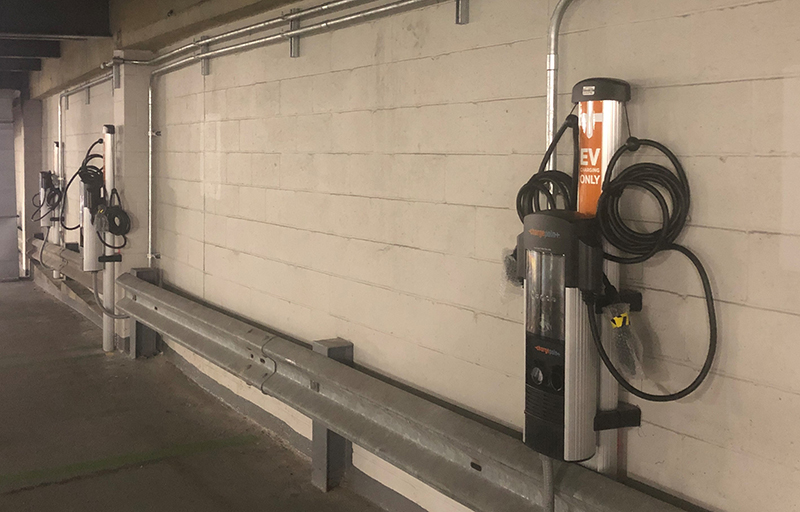
Implementing vehicle charging stations is easier than you think - by Hall and Alpert

The interest and demand for electric vehicle (EV) charging stations is already high and is expected to explode as they become more commonplace as commercial businesses and municipalities alike consider installing them at their facilities. This increase in demand is primarily due to the need to reduce emissions from internal combustion engine vehicles.
A variety of financial incentives from federal and state governments and utilities are available to make installing EV charging stations reasonably priced. In the United States, there are currently over 50,000 EV charging stations available1 and the process to install them is becoming more streamlined as contractors become ready. For example, here in New England, some utilities in CT offer up to $250,000 in incentives for one location, while in Vermont, the highest current incentive is $1,500 per charging station.
There are three charging station options – Levels 1, 2, and 3. The difference between these options is the size, cost, speed of charge, voltage, and premium options such as interface and networking communications. The chart illustrates the differing options and characteristics for charging stations.

Both local and federal governments are looking to EVs as a solution to combat climate change and to reduce our dependence on fossil fuels. More utilities are allowing programs to help “make ready” the infrastructure required for charging stations and making public access EV charging points more commonplace. Implementing new EV charging stations is cheaper and easier than you may think, but there are some best practices that you should be aware of.
Best Practices: It is important to mention that various jurisdictions have already gone through the legwork of developing sets of best practices for those who are just beginning to explore the EV charging station installation market. One New York-based construction and maintenance company has even published its own best practices guide for installing charging stations 2.
One of your first priorities should be to understand the current and future demand for EV charging stations, how often they will be utilized, and the amount of pedestrian traffic that is expected to occur in the area. Understanding the volume of pedestrian traffic will help the designer mitigate the risk of trip hazards and prevent the charging station and cable from interfering with the existing environment.
Prepare Your Facility to be Charging Station Ready: If you are considering installing EV charging stations, you should first survey your customers, owners, and/or visitors to verify the demand for such facilities. Secondly, you should identify the existing local EV charging station locations to verify there is even a need for more. Finally, you need to determine the most appropriate physical location of the concrete pads for the charging stations and any bollards to protect the device.
How to Overcome Barriers: A helpful guide related to primary site design factors applicable to any site, such as accessibility and ease of use, visibility, and safety, can be found in the “Siting and Design Guidelines for Electric Vehicle Supply Equipment,”3 Other barriers and factors for consideration include the following:
1.) Infrastructure
a.) Reaching out to the local electric utility early will help identify any electric network upgrades, metering needs, and other utility related financial considerations.
b.) Determine the most appropriate location(s) for EV charging stations with respect to the building’s power supply
2.) Parking
a.) Determine the optimum parking space size and orientation for EV charging stations
3. ) Architecture
a.) Factor in landscaping, walkways, curb cuts, and lighting and visibility
4.) ADA/HC (accessibility)
a.) The Massachusetts EV Incentive Program (EVIP), for example, requires one accessible EV charging station space per installation, with a 5% minimum per parking area4.
b.) A 16-foot width minimum is required for clearance5.
c.) There should be no more than 3-5 feet of cord distance to minimize trip hazards6.
Data show that EV charging stations can also enhance real estate values7 by making it as easy to charge your EV as it is to fill up your car or truck with fuel. The resources that are already available to design and implement EV charging stations, including local “Make Ready” contractors and the financial incentives from governments and utilities, will continue to make public access to EV charging stations more financially viable and affordable for all communities.
Johanna Hall, EIT, CEM is team leader and Sam Alpert, CEA, CEM, EIT is a technical specialist at Weston & Sampson in Reading, Mass.
1. https://afdc.energy.gov/fuels/electricity_locations.html#/find/nearest?fuel=ELEC
2. https://ferrandinoandson.com/best-practices-for-ev-charging-station-operations-and-maintenance-policy-guidelines/
3. https://www.nyserda.ny.gov/-/media/Project/Nyserda/Files/Programs/ChargeNY/Siting-and-Design-Guidelines-for-EVSE.pdf
4. https://www.mass.gov/doc/massevip-public-access-charging-requirements/download`
5. https://www.mass.gov/doc/massevip-public-access-charging-requirements/download`
6. https://www.nyserda.ny.gov/-/media/Project/Nyserda/Files/Programs/ChargeNY/Siting-and-Design-Guidelines-for-EVSE.pdf
7. https://evocharge.com/resources/ev-charger-increase-property-value/
